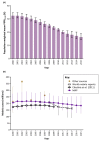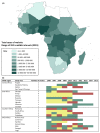Changes in Malaria Epidemiology in Africa and New Challenges for Elimination
- PMID: 27939610
- PMCID: PMC6995363
- DOI: 10.1016/j.pt.2016.11.006
Changes in Malaria Epidemiology in Africa and New Challenges for Elimination
Abstract
Although the burden of Plasmodium falciparum malaria is gradually declining in many parts of Africa, it is characterized by spatial and temporal variability that presents new and evolving challenges for malaria control programs. Reductions in the malaria burden need to be sustained in the face of changing epidemiology whilst simultaneously tackling significant pockets of sustained or increasing transmission. Large-scale, robust surveillance mechanisms that measure rather than estimate the actual burden of malaria over time from large areas of the continent where such data are lacking need to be prioritized. We review these fascinating developments, caution against complacency, and make the case that improving the extent and quality of malaria surveillance is vital for Africa as she marches on towards elimination.
Keywords: Africa; Plasmodium falciparum; elimination; epidemiology; malaria control.
Copyright © 2016 The Authors. Published by Elsevier Ltd.. All rights reserved.
Figures



References
Publication types
MeSH terms
Grants and funding
LinkOut - more resources
Full Text Sources
Other Literature Sources

